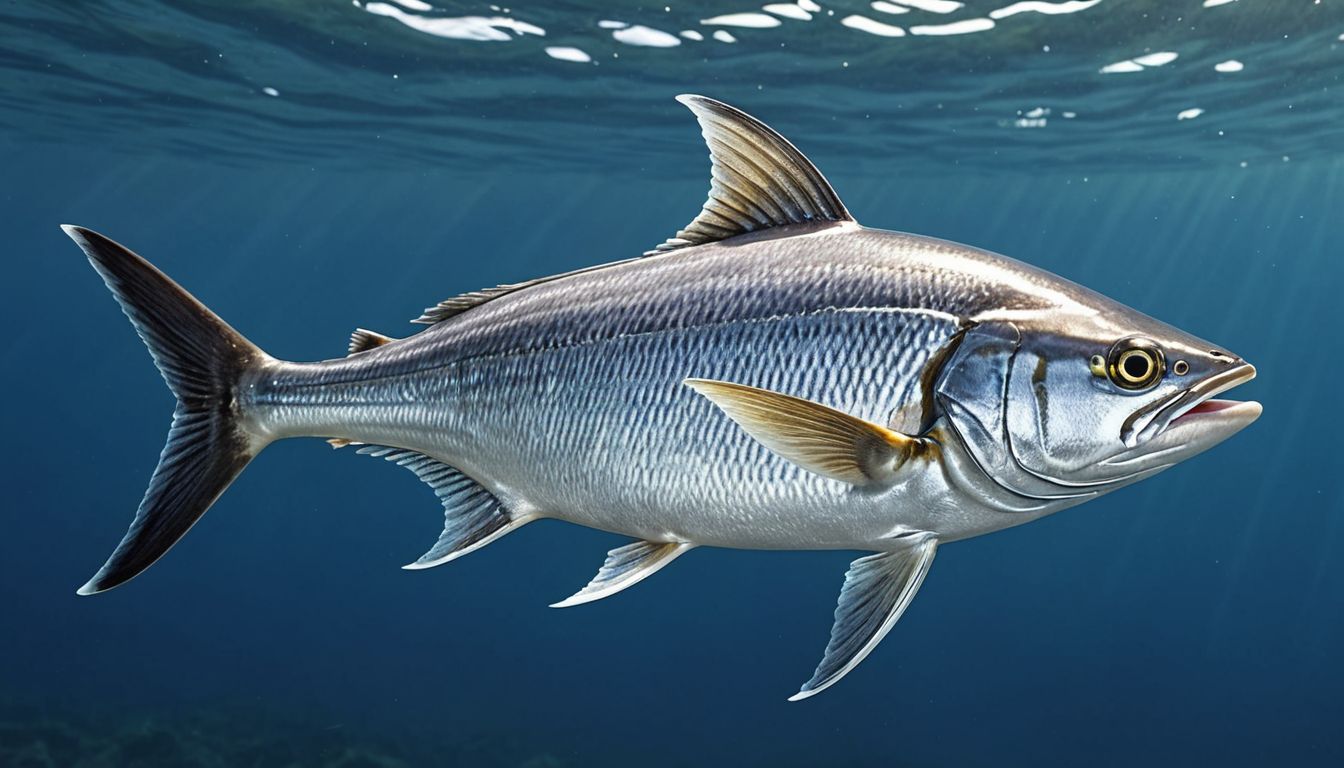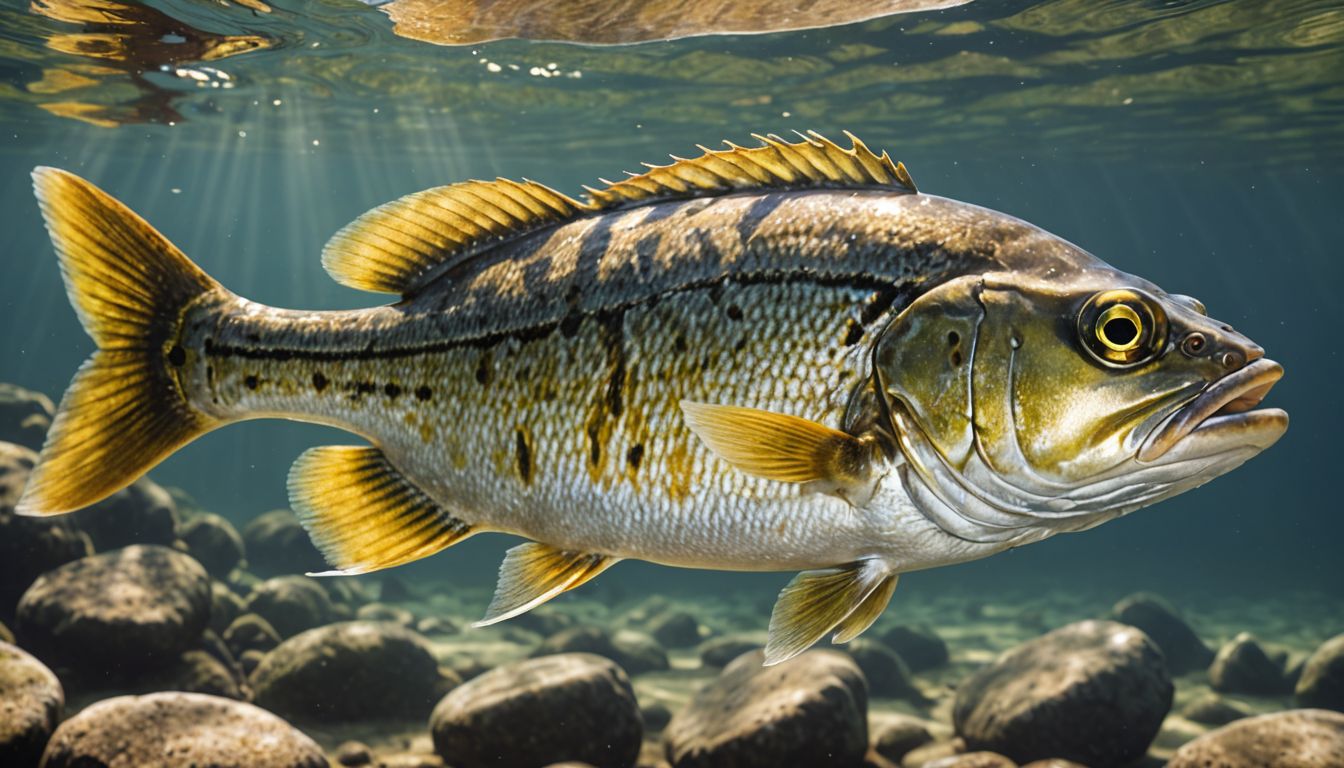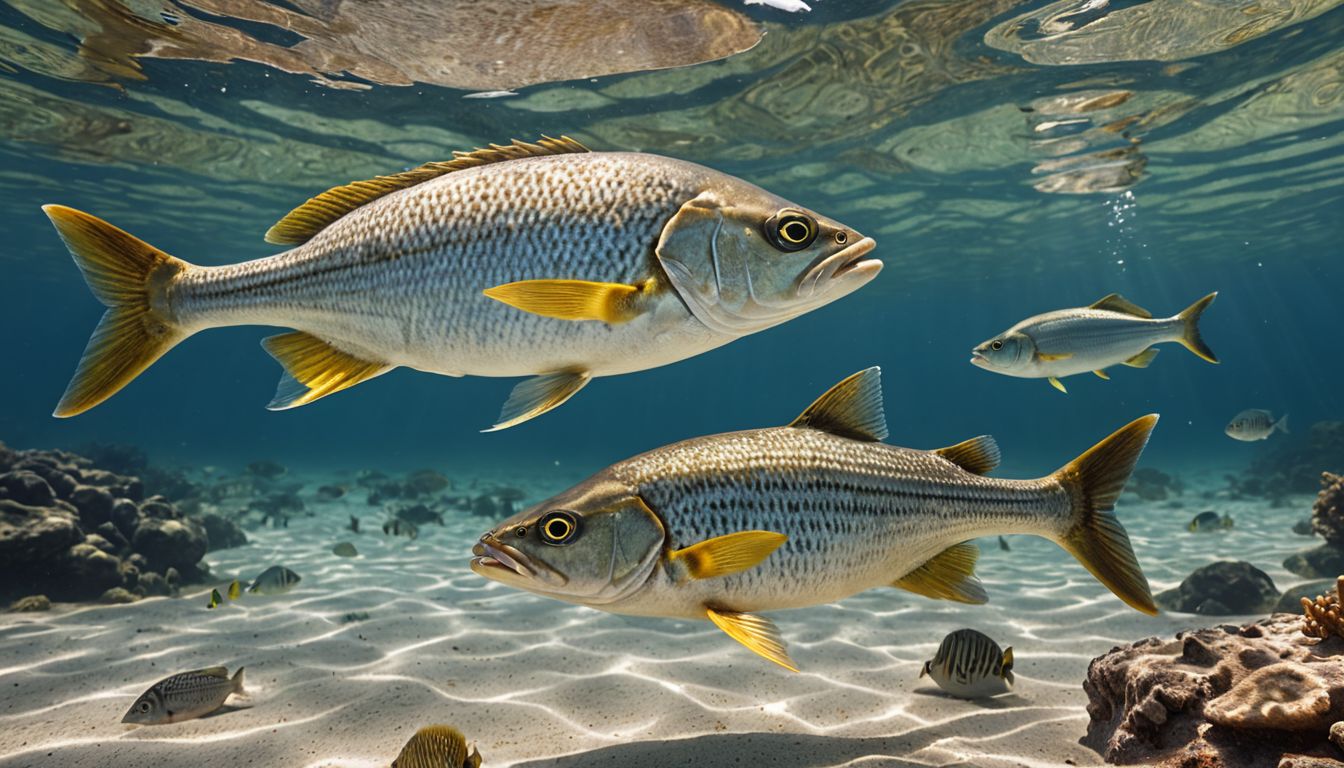If you’re an angler or someone who loves marine life, you’ve probably encountered corbina and croakers. Both fish species share similarities, yet their differences are equally intriguing. This article breaks down their distinctions, diving into their physical characteristics, habitats, feeding habits, and the best ways to catch them.
Corbina vs. Croaker: Understanding the Basics
The California corbina (Menticirrhus undulatus) and croakers belong to the same family, Sciaenidae, commonly referred to as the drum fish family. This group is named for their ability to produce a drumming or croaking sound. However, despite these shared traits, there are clear distinctions between the two.
1. Physical Characteristics
Corbina
- Appearance: Corbina are sleek, silvery fish with a torpedo-shaped body. They have an elongated structure and are often mistaken for mullet due to their streamlined build.
- Size: Corbina grow up to 20 inches and can weigh around 4 pounds on average.
- Mouth Features: A key distinguishing feature of corbina is their underslung mouth, which is used to sift through sand for prey. They do not have barbels (whisker-like structures).

Croaker
- Appearance: Croakers are more robust and have a stockier body compared to corbina. Their color varies, often displaying golden hues with darker markings on their sides.
- Size: Common croakers can reach a length of 18 inches, although certain species grow larger.
- Mouth Features: Unlike corbina, croakers have small, visible barbels near their mouth, helping them detect prey in murky waters.

2. Habitat and Distribution
Corbina
- Found primarily along the coastal regions of Southern California and Baja California.
- Prefer sandy beaches and shallow waters close to the shore.
- Known to thrive in areas with rolling surf and sandbars where they can sift through sediments for food.
Croaker
- Distributed across a broader range, including both Atlantic and Pacific coasts.
- Commonly inhabit estuaries, lagoons, bays, and nearshore areas.
- Some species, like the Atlantic croaker (Micropogonias undulatus), tolerate deeper and brackish waters, making their range more versatile.
Habitat Overlap:
While corbina are strictly nearshore fish, croakers often explore deeper and more varied environments, increasing their adaptability.
3. Feeding Habits
Corbina
- Corbina are bottom feeders, relying heavily on their sensitive lips to detect food buried in sand. Their diet primarily includes:
- Sand crabs
- Small mollusks
- Marine worms
Croaker
- Croakers have a slightly broader diet due to their barbels, allowing them to forage in muddy or turbid environments. They consume:
- Shrimp
- Small fish
- Crustaceans
This dietary difference makes corbina more selective feeders, while croakers adapt easily to various conditions.
4. Fishing Techniques
If you’re planning to fish for these species, knowing their habits can be a game-changer.
Corbina Fishing Tips:
- Bait: Sand crabs and bloodworms are the best bait for corbina.
- Techniques: Since corbina roam shallow waters, casting close to shore often yields results.
- Timing: Early mornings and evenings are ideal when tides are rolling in.
Croaker Fishing Tips:
- Bait: Shrimp, squid, or even artificial lures mimic the croaker’s preferred prey.
- Techniques: Croakers can be caught from jetties, piers, or boats, thanks to their wide habitat range.
- Timing: Croakers bite readily in low light conditions and during tidal changes.
Key Difference:
Corbina present a greater challenge for anglers due to their skittish behavior, while croakers are often easier to catch and more forgiving.
Why the Confusion Between Corbina and Croakers?
Both species belong to the same family, so their physical and behavioral similarities cause confusion. Here’s why anglers often mix them up:
- Sound Production: Both can “croak” or “drum” due to specialized muscles near their swim bladder. However, croakers are far more vocal than corbina.
- Habitat Overlap: Anglers fishing off Southern California beaches may encounter both species in the same area.
- Similar Bait Preference: Both are attracted to shrimp and small crustaceans, which adds to the misunderstanding.
Importance in Ecosystems and Recreational Fishing
Corbina
- Corbina play a significant role in coastal ecosystems by controlling populations of sand crabs and other invertebrates.
- They are considered a prized catch among anglers for their elusive behavior and fight on the line.
Croaker
- Croakers help maintain the balance of estuarine ecosystems by preying on shrimp and smaller fish species.
- As one of the more commonly caught fish, they serve as a food source for recreational and commercial purposes.
Conclusion: The Unique Identities of Corbina and Croaker
In summary, the key differences between corbina and croakers lie in their physical features, habitat preferences, and feeding behaviors. Corbina are sleek, sand-feeding specialists often found along beaches, while croakers are stockier, adaptable, and equipped with barbels for varied feeding environments.
Both species hold unique value for anglers and play critical roles in maintaining healthy ecosystems. Whether you’re fishing off a California shore or exploring estuaries, recognizing their distinctions ensures a more rewarding experience.
FAQs
- Are corbina and croaker the same fish? No, corbina and croakers are related but distinct species within the drum fish family.
- What is the best bait for corbina? Sand crabs and bloodworms are the most effective bait.
- Do corbina have barbels? No, corbina lack barbels, unlike croakers, which have small whisker-like structures.
- Where can I find corbina? Corbina are commonly found in shallow waters along sandy beaches in Southern California.
- Are croakers easier to catch than corbina? Yes, croakers are generally less wary and more abundant than corbina.
- What does a croaker sound like? Croakers produce a drumming or croaking sound using their swim bladder muscles.
- Can I eat corbina? Yes, but they are often released by anglers due to their lower population compared to croakers.
- How big do corbina get? Corbina can grow up to 20 inches in length and weigh around 4 pounds.
- Do corbina and croakers live in the same waters? Yes, they sometimes overlap in coastal waters but prefer slightly different habitats.
- Why are croakers called “croakers”? Their ability to produce a croaking sound is the reason behind their name.
Part 2: Corbina vs. Croaker: A Deeper Dive into Their Unique Features
Now that we’ve explored the foundational differences between corbina and croakers, let’s dig deeper into their behavioral patterns, ecological roles, and angling techniques. This part will help you further differentiate these species and understand their significance in recreational fishing and the marine ecosystem.
1. Behavioral Patterns of Corbina and Croakers
Understanding the behavioral tendencies of corbina and croakers can significantly enhance your ability to identify and catch them.
Corbina Behavior
- Feeding Behavior: Corbina exhibit a unique foraging style. They swim close to the shoreline in search of sand crabs, often sticking their snouts into the sand to extract prey. This behavior makes them highly reliant on sandy, shallow areas.
- Movement Patterns: They are known for their cautious nature, making them one of the more elusive species for anglers. Corbina often patrol surf zones, blending with the environment to avoid predators and humans.
- Social Behavior: Corbina are often found solitary or in small groups, making them less visible compared to croakers, which may travel in larger schools.
Croaker Behavior
- Feeding Behavior: Croakers are opportunistic feeders, often relying on their barbels to detect prey in darker or murkier waters. This adaptability allows them to thrive in a broader range of conditions.
- Movement Patterns: Unlike corbina, croakers exhibit a schooling behavior, which often makes them easier to locate.
- Sound Communication: Croakers use their croaking sounds as a form of communication, particularly during mating seasons. This sound can also help anglers detect their presence.
Key Difference: Corbina are selective and cautious feeders, while croakers are opportunistic and tend to congregate in larger groups.
2. Role in Ecosystems
Both corbina and croakers play essential roles in maintaining balanced marine ecosystems. However, their specific contributions differ due to their feeding habits and habitats.
Corbina’s Role
- Corbina primarily target sand crabs, keeping their populations in check.
- As prey, corbina are an important food source for larger marine predators, including sharks and rays.
- Their shallow water habitat makes them a significant part of coastal ecosystems, contributing to nutrient cycling in surf zones.
Croaker’s Role
- Croakers, with their broader diet, regulate populations of shrimp, small fish, and crustaceans in estuarine and nearshore ecosystems.
- Their schooling behavior makes them a crucial food source for larger predators, including dolphins, seals, and larger fish species.
- By feeding in both estuarine and open waters, croakers help transfer nutrients across ecosystems.
Key Takeaway: While both species contribute to the food web, corbina are more specialized feeders, whereas croakers have a broader ecological impact due to their varied diet.
3. Angling Challenges: Catching Corbina vs. Croakers
Both species offer unique challenges for anglers, but your strategy needs to be tailored to their behavior and habitat.
The Challenge of Catching Corbina
- Corbina are nicknamed the “ghosts of the surf” due to their ability to blend seamlessly with sandy ocean floors.
- Challenges:
- They spook easily, requiring stealth and finesse from anglers.
- Corbina often bite lightly, making it harder to set the hook.
- Solutions:
- Use natural bait like fresh sand crabs or ghost shrimp.
- Avoid casting too far; corbina are often just beyond the breaking waves.
- Use light tackle to maintain a delicate presentation.
Catching Croakers: Easier but Still Rewarding
- Croakers are more forgiving, often striking aggressively and traveling in larger schools.
- Challenges:
- While easier to hook, croakers can sometimes be elusive in murky conditions.
- Solutions:
- Use bait such as squid, shrimp, or artificial lures to mimic their prey.
- Fish during tidal changes or at dusk when croakers are most active.
- Target piers and jetties where croakers frequently school.
Angler’s Tip: Corbina require patience and precision, while croakers are more suitable for beginners looking for a successful catch.
4. Corbina and Croaker in Recreational Fishing Culture
Both corbina and croakers are highly sought after in the recreational fishing community. However, their appeal differs based on the challenges and rewards they offer.
Corbina: The Trophy Catch
- Corbina are considered a prize among anglers due to their elusive behavior and powerful fight when hooked.
- Catch-and-release is common for corbina, as they are not as abundant as other fish species. Many anglers see catching corbina as a test of skill rather than a source of food.
- The thrill of sight-fishing for corbina in the surf adds to their mystique.
Croaker: The Reliable Catch
- Croakers, particularly the Atlantic croaker, are abundant and relatively easy to catch, making them a favorite among beginners and families.
- Due to their mild flavor and versatility in cooking, croakers are popular as a food source.
- For many, catching croakers is less about the challenge and more about the enjoyment of fishing.
Cultural Insight: Corbina symbolize a skillful angler’s trophy, while croakers provide a reliable, fun, and rewarding fishing experience.
5. Conservation and Management
With growing concerns about overfishing and habitat degradation, the conservation of both corbina and croaker populations is essential for sustainable fishing.
Corbina Conservation Efforts
- Corbina are less abundant and more vulnerable to overfishing, particularly due to their nearshore habitat, which is heavily impacted by human activity.
- Sustainable practices, such as catch-and-release, are encouraged to maintain their populations.
- Protecting surf zones and reducing beach pollution is critical for corbina survival.
Croaker Conservation Efforts
- Croakers, being more abundant, face fewer immediate threats. However, certain species, like the Atlantic croaker, are susceptible to overharvesting in some areas.
- By monitoring fishing limits and protecting estuarine habitats, fisheries management aims to ensure healthy croaker populations.
Sustainable Practices:
- Follow local fishing regulations regarding size and bag limits.
- Use non-lead tackle to reduce environmental contamination.
- Respect the natural habitats of both species by minimizing disturbances.
Final Thoughts: Which Fish Is Right for You?
- If you’re looking for a challenging and rewarding fishing experience, corbina are the ultimate test of skill. Their stealthy behavior and fight on the line make them the holy grail for surf anglers.
- If you prefer a more relaxed outing with a higher chance of success, croakers are your go-to species. Their abundance and willingness to bite make them perfect for casual anglers.
Whether you choose the sleek and elusive corbina or the versatile and abundant croaker, both species offer unforgettable experiences that highlight the joys of recreational fishing.
FAQs (Continued)
- What’s the best time to catch croakers? Early morning or evening, especially during tidal shifts, is ideal for catching croakers.
- Are corbina seasonal fish? Yes, corbina are more active in warmer months, typically from spring to late summer.
- Can croakers live in freshwater? No, croakers require brackish or saltwater environments.
- Do corbina make noise like croakers? Corbina rarely produce sounds, unlike croakers, which are known for their croaking.
- Which fish tastes better: corbina or croaker? Croakers are more commonly eaten, while corbina are often released due to their smaller population.
- What size hooks are best for corbina? Small, sharp hooks (#6 to #2) work best for corbina due to their feeding style.
- Can I catch corbina with artificial lures? It’s possible, but live bait like sand crabs is far more effective.
- Are croakers good for beginners? Yes, croakers are easier to catch and a great option for new anglers.
- Do corbina migrate? Corbina tend to stay within their home ranges but may move to slightly deeper waters in winter.
- What’s the legal limit for croaker fishing? Limits vary by region, so always check local regulations before fishing.

